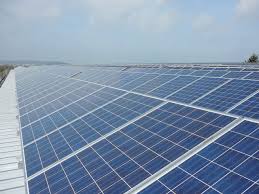A team of researchers at the Massachusetts Institute of Technology (MIT) has announced a development that could change the way solar energy is used. If successful, the breakthrough could make the adoption of solar energy even cheaper and several times more effective. A recent report in the Daily Mail states that the scientists have developed an extremely light solar cell, which the scientists claim weighs the same as a soap bubble.
The new technique, if proven effective, could be applied to virtually any surface to capture solar energy. The energy-capturing material could thus turn prevailing energy paradigms around, allowing consumers to save hundreds of dollars in their endeavor to harness energy from the sun and reduce dependence on fossil-fuel-based energy.
MIT scientists, while demonstrating the capabilities of the new solar cells, were able to balance a solar cell on a soap bubble without the latter popping. According to the team of researchers, they made use of parylene, a common plastic, to create the ultra-lightweight solar panels. The plastic, in effect, serves as an ultra-thin coating. Parylene is a unique material in that it can be made into a layer that’s as thin as a single layer of cling film. They also used DBP, a material that helps capture light, to form the outer layer of the solar cell.
With their stunningly low weight, the new solar cells can be applied to virtually any object that needs to be charged but cannot be fitted with clunky batteries for practical purposes.
The solar panels didn’t disappoint on the energy generation front too, as they were able to produce six watts of power per single gram of their weight. This also marks a new high in solar panel efficiency, as the existing generation of solar panels do not boast the same degree of efficiency. Silicon-based cells, which are currently most popular, produce 15 watts of power per kg of material.
Applications of this new material could also prove to be exciting, especially if it is used in space exploration expeditions.
The new technique, if proven effective, could be applied to virtually any surface to capture solar energy. The energy-capturing material could thus turn prevailing energy paradigms around, allowing consumers to save hundreds of dollars in their endeavor to harness energy from the sun and reduce dependence on fossil-fuel-based energy.
MIT scientists, while demonstrating the capabilities of the new solar cells, were able to balance a solar cell on a soap bubble without the latter popping. According to the team of researchers, they made use of parylene, a common plastic, to create the ultra-lightweight solar panels. The plastic, in effect, serves as an ultra-thin coating. Parylene is a unique material in that it can be made into a layer that’s as thin as a single layer of cling film. They also used DBP, a material that helps capture light, to form the outer layer of the solar cell.
With their stunningly low weight, the new solar cells can be applied to virtually any object that needs to be charged but cannot be fitted with clunky batteries for practical purposes.
The solar panels didn’t disappoint on the energy generation front too, as they were able to produce six watts of power per single gram of their weight. This also marks a new high in solar panel efficiency, as the existing generation of solar panels do not boast the same degree of efficiency. Silicon-based cells, which are currently most popular, produce 15 watts of power per kg of material.
Applications of this new material could also prove to be exciting, especially if it is used in space exploration expeditions.

No comments:
Post a Comment